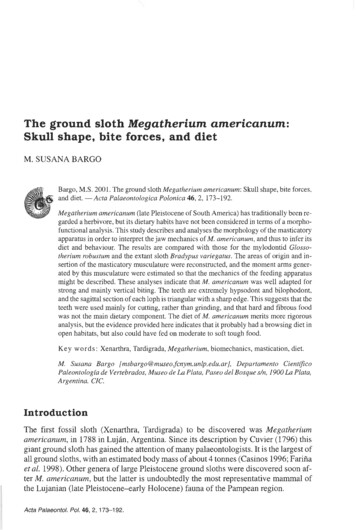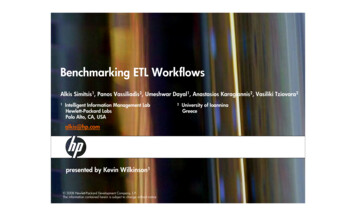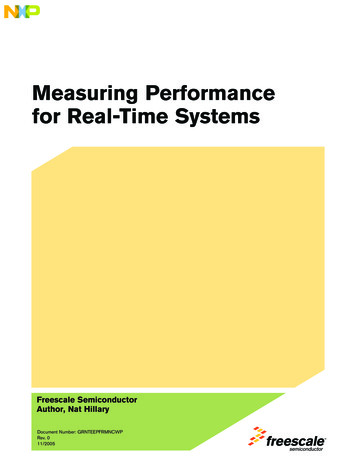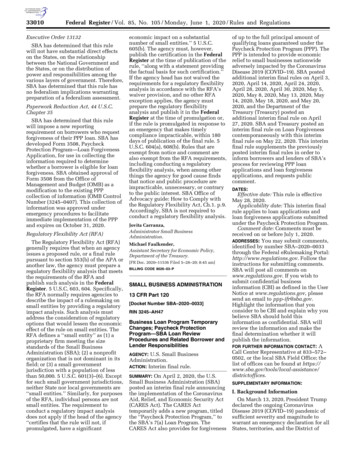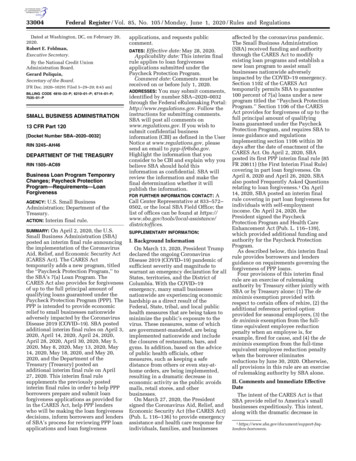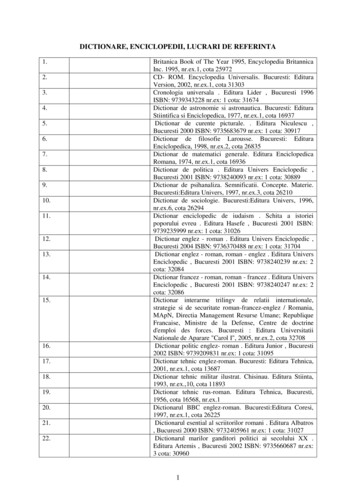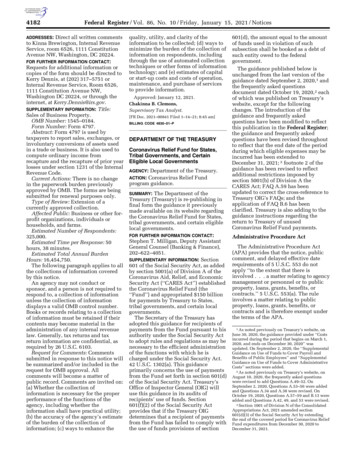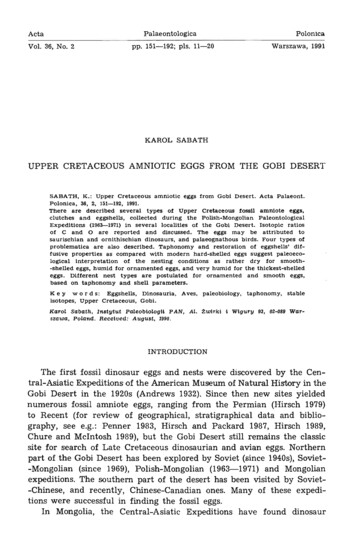
Transcription
ActaPalaeontologicaVol. 36, No. 2pp. 151-192;pls. 11-20PolonlcaWarszawa, 1991KAROL SABATHUPPER CRETACEOUS AMNIOTIC EGGS FROM THE GOBI DESERTSABATH, K.: Upper Cretaceous amniotic eggs from Gobi Desert. Acta Palaeont.Polonica, 36, 2, 151-192, 1991.There are described several types of Upper Cretaceous fossil amniote eggs,clutches and eggshells, collected during the Polish-Mongolian PaleontologicalExpeditions (1963-1971) in several localities of the Gobi Desert. Isotopic ratiosof C and 0 are reported and discussed. The eggs may be attributed tosaurischian and ornithischian dinosaurs, and palaeognathous birds. Four types ofproblematica are also described. Taphonomy and restoration of eggshells' diffusive properties as compared with modern hard-shelled eggs suggest paleoecological interpretation of the nesting conditions as rather dry for smooth-shelled eggs, humid for ornamented eggs, and very humid for the thickestahelledeggs. Different nest types are postulated for ornamented and smooth e g g ,based on taphonomy and shell parameters.K e y w o r d s: Eggshells, Dinosauria, Aves, paleobiology, taphonomy, stableisotopes, Upper Cretaceous, Gobi.Kmol Sabath, Instytut Paleobiologti PAN, dl. Zwtrki i Wiguryszawa, Poland. Received: August, 1990.93, 02-089War-INTRODUCTIONThe first fossil dinosaur eggs and nests were &scovered by the Central-Asiatic Expeditions of the American Museum of Natural His*in theGobi Desert in the 1920s (Andrews 1932). Since then new sites yieldednumerous fossil amniote eggs, ranging from the Permian (Hirsch 1979)to Recent (for review of geographical, stratigraphical data and bibliography, see e.g.: Penner 1983, Hirsch and Packard 1987, Hirsch 1989,Chure and McIntosh 1989), but the Gobi Desert still remains the classicsite for search of Late Cretaceous dinosaurian and avian eggs. Northernpart of the Gobi Desert has been explored by Soviet (since 1 9 4 0 Soviet) -Mongolian (since 1969), Polish-Mongolian (1963-1971) and Mongolianexpeditions. The southern part of the desert has been visited by Soviet-Chinese, and recently, Chinese-Canadian ones. Many of these expeditions were successful in finding the fossil eggs.In Mongolia, the Central-Asiatic Expeditions have found dinosaur
Fig. 1. Egg-bearmg sites visltea DY rne Polish-Mongolian Paleontological Expeditions (1963-19711,and Gradzifiski and Jerzykiewicz (1972). Scale bars in insets equal1 km. Abbreviations: C.S.Eastern Sayr; W.S. - Western Sayr; R. - "Ruins"; V. - "Volcano" ( "PyramidM).E.S.modified after Gradzifiski et al. (1969)Central Sayr; M.S. - i sayr;-
UPPER CRETACEOUS EGGS FROM GOBI DESERT153nests and eggs a t a locality mmed Shabarakh Usu ( Bayn Dzak; Andrews 1932: 162-163, 207-214). The eggs found there were attributed toa ceratopsian dinosaur Protoceratops andrewsi, since its bones were common in the same fossil-bearing strata. Claims regarding direct identification of taxonomic position of the egg-laying animal via recognition ofthe dinosaur embryos inside the eggs (Andrews 1932: 210) though longpersisting in the literature (e. g. Kitching 1979) proved to be unfounded(Elianowski 1981). Only hatched juveniles of Mongolian protoceratopsiddinosaurs are known (Coombs 1980). "Protoceratops" eggs' morphologywas described shortly after their discovery (Van Straelen 1925), latertheir microstructure was revealed (Schwartz et al. 1961, 1962) as well astheir ultrastructure (SEM study by Erben 1970, who studied, in fact,mostly elongatoolithid and not protoceratopsid eggshells; see Mikhailov1991). Another type of eggs - smaller and smooth-shelled - was alsomentioned by Andrews (1932) as common in Shabarakh Usu.The Soviet Paleontological Expeditions working in Mongolia from1946 till 1949 and subsequent Joint Soviet-Mongolian Paleontological andGeological Expeditions also have found eggs and eggshells, described laterby Sochava (1969, 1970, 1971, 1972), who distinguished in the MongolianCretaceous material at least three types of eggshells: angusticanaliculate,prolatocanaliculate and multicanaliculate. Paleobiochemical studies onthese eggs (Kolesnikov and Sochava 1972) revealed that some shell scleropeptides were preserved. Other bio- and geochemical analyses on thePlongoljan and other Cretaceous eggshells were also done by Krarnpitzet al. 1977, Schwartz et al. 1961, verzilin and Rogozina 1981, Verzilinet al. 1985 and Dauphin and Jaeger 1990). The main Soviet fossil eggcollection (housed in the Paleontological Institute, U.S.S.R. Academy ofSciences, Moscow) was restudied by Mikhailov (1988, 1991).The rich Mongolian collection of fossil eggs (including part of thefossil material found by the Polish-Mongolian expeditions) has not beendescribed yet.The Chinese part of the Gobi Desert yielded recently five types ofCretaceous eggs, but only preliminary information was published (Zhiming et al. 1989). For bibliography of numerous earlier fossil egg finds inChina see Zhen et al. 1985.Polish collection of Upper Cretaceous fossil eggs from Gobi desert,gathered since 1963 to 1971, is remarkably abundant. It comprises about300 specimens of eggs and egg fragments as well as abundant shell debris,belonging to as much as 10 different groups. Being, at least at the timeof completing, one of the world's most diverse single set of Mesozoic eggs,it has been only preliminarily mentioned so far (Malecki 1977, Mierzejewska 1977, 1981).The aim of the present paper is to describe the collection, housed at5 Acta Palaeontologica PolonicaNr 2/91
154.KAROL SABATHthe Institute of Paleobiology of the Polish Academy of Sciences in Warsaw(ZPAL), and to present some paleobiological speculations concerningadaptation aspects of fossil eggs.Acknowledgement. - The author wishes to thank Dr. K. E. Mikhailov (Paleontological Institute of the U.S.S.R. Academy of Sciences, Moscow) for sharing hisunpublished thesis manuscript, comparative material and valuable discussions, Prof.Z. Kielan-Jaworowska, Dr. M. Biczycki (The Silesian University, Katowice), the staffof the Silesian Zoo (Chorzbw) for fossil and Recent comparative shell material.Dr. M. Gruszczyliski (Institute of Paleobiology, Polish Academy of Sciences) performed the stable isotope analysis of the eggshells. Thanks are also due to thefollowing members of the technical staff of the Institute of Paleobiology, Polish Academy of Sciences: Mr. W. Skariyliski for technical assistance with SEM and forproviding photographs of a nest in situ, Mr. Z. S t r kand Ms. M. Nowiliska formaking the thin section preparations, Mr. M. Dziewiliski and Ms. G. Podbielska forphotographing the specimens. Ms. G. Mierzejewska made available numerous eggshellpreparations. Prof. H. Osmblska and prof. Z. Kielan-Jaworowska provided helpfulcomments on the manuscript.GENERAL REMARKS ON EGGSHELL STRUCTURE AND TERMINOLOGYMethodsThe shell portions to be analyzed in SEM were either non treatedinternal, external and radial fracture surfaces or treated surfaces offractures or radial sections embedded in epoxy. Etching has been performed with 1 /o HCl, 10 /o EDTA, Cr,(SO)* or by boiling in KOH. Thespecimens were then glued to brass specimen holder with colloidal silverand subsequently coated with gold in vacuo. The SEM micrographs weretaken using JEOL (Japan Electronic Optical Laboratories) SM-1 scanningmicroscope at the Nencki Institute of Experimental Biology of the PolishAcademy of Sciences, Warsaw.The radial and tangential thin sections of eggshells embedded in epoxywere also viewed and photographed in normal and polarized light usingOlympus SZH stereomicroscope.The paleophysiological estimates were made by solving allometricequations for extant birds, since they are the closest living relatives ofdinosaurs and their eggshell structure seems to correspond better to thedinosaur eggshells studied than less mineralized crocodilian or chelonianeggshells do (Table 1).The eggshell sample material for isotope analysis was treated by purephosphoric acid (McCrea 1950) and the resulting carbon dioxide studiedby mass spectrometry at the Institute of Physics, Maria Curie-Sklodowska University, Lublin, Poland. The standard error of single measurements is less than 0.08 per mille (Halas and Sk6rzynski 1982). The resultsare expressed in delta notation relative to the PDB standard, using theNBS-19 reference sample.
155U P P E R CRETACEOUS EGGS FROM GOBI DESERTFig. 2. Different geometrical approximations of the egg shape. R greater radius;r lesser radius; d long axis of an egg, h height of cylinder or frustum.upper view/transverse radial sectionradial fracture (radial view)Fig. 3. The principal topological terms concerning the egg and eggshell preparations.Egg and eggshell general morphology (fig. 2, 6)The eggs studied are of spherical, ovate, elongate ovate or elongateellipsoidal shape (fig. 6). The blunt end of asymmetric eggs (possiblycontaining the air chamber in vivo) was presumably directed upwards,as in extant species and in the North American ornithopod nests (Horner1984, 1987, Coombs (1989). The outer (external) surface of eggshell may
156KAROL SABATHappear smooth to the naked eye or shows different patterns of sculpturedornament. I follow Mikhailov's (1991) nomenclature of such patterns andpore systems.Shell micro- and ultrastructureSince the 19th century it has been known that avian eggshell consistsprincipally of two layers, of which the one adhering to the egg membraneforms small cusps, and the other one is more uniform. Nevertheless,several synonymical terms have been introduced to point at differentproperties (morphological or crystallographical) of shell unit and subunitsas visible under ULM, PLM, and SEM, thus somewhat obscuring theunderstanding of eggshell structure. Because descriptions of various authors differ in terminology, I present a scheme, illustrating the relationships of certain terms (pl. 14, fig. 3, 4). Since Mikhailov (1991) presentshis exhaustive analysis of shell ultrastructure, resulting from his studieson rich material, including analogous Cretaceous Gobi eggshells, I omitaccretion lines-,eisospherite(basal plate group) ---------Lshellnilrnbrane secondarylspheriteorganic corei r e s)rotion crater'z&xFig. 4. Different aspects of the structure and nomenclature of ornithoid eggshell.A. Freshly laid egg (based on Recent ratite eggshells). B. Fossil incubated egg (noteresorption craters and the herring-bone pattern). A and B as seen in SEM. C. Radialthin section of an incubated eggshell, polarized light. D. Radial thin section, transmitted light. Another features can be visualised after chemical staining of theRecent eggshells (Tyler and Simkiss 1959).
UPPERCRETACEOUS EGGS FROM GOBI DESERT157here a detailed discussion on the meaning of particular structuresvisible in the micrographs. For a comparative presentation of microstruc ture of the eggs from the collection described here see fig. 8.The herring-bone pattern (fig. 4B) ("fish-bone pattern") described byErben (1970) as a n important structural feature of the outer layer of dinosaurian eggshells proved to be a typical result of diagenesis. This particularpattern of cracks is visible on fossil eggshell fractures and not in thefresh material (Hirsch 1984: fig. 5), and results from cleavage of calciteafter decay of organic matrix (Mikhailov 1991).Abbreviations usedAs - eggshell surface area [cmg]A - single pore section area (average) [cmejAp - total functional pore area [cme]D - egg length [mm]d - egg equatorial diameter [mm]DHZO- diffusion coefficient for water vapor in air [ m . s e c - ]GHZO- water vapor conductance of the eggshell [mg.(day .Torr)-ljI - incubation period [days]L - length of pores (shell thickness) [mm]MHZO- water loss rate [mgwday-11Nnumber of poresT - absolute incubation temperature [K]V - egg volume [cma]W - egg fresh weight [GIZPAL MgOv - Institute of Paleobiology, Polish Academy of Sciences, collectionof Mongolian eggs.ZPAL zpOv - comparative collection of eggshells.-STRATIGRAPHIC AND GEOGRAPHIC SETTINGThe fossil egg collection studied here comes from the following localities visited by the Polish-Mongolian Paleontological Expeditions (Kielan-Jaworowska and Dovchin 1969, Kielan-Jaworowska and Barsbold1972):1. Bayn Dzak ( Shabarakh Usu; Andrews, 1932: 162-163, 207-214;Gradziliski et al. 1969: 69-72). The eggs found in that locality by theAMNH Central Asiatic Expeditions in 1923 and 1925 (Andrews 1932:208-211,256-257) were described by Van Straelen (1925), Schwartzet al. (1961) and Erben (1970). They represented mainly two types: a largerone, attributed to Protoceratops, and a medium size one, regarded byAndrews as laid by another dinosaur. Andrews called Shabarakh Usu"a dinosaur nesting place", where properties of sand suited the incubationrequirements best. The amount and diversity of eggs found in Bayn Dzak
158KAROL SABATHby members of the Polish-Mongolian Paleontological Expeditions supportAndrews' statement.All the Bayn Dzak material comes from the deposits of the DjadokhtaFm. (?late Santonian or early Campanian; Gradzihski et al. 1977).2. Toogreeg (Tugruk, Tugrikin-Shire) is ca 30 km WNW of BaynDzak (Gradzinski and Jerzykiewicz 1972: 29-30) and the Toogreeg bedsare biostratigraphic equivalent of the Djadokhta Fm. (Gradzinski et al.1977: 302). Fossil eggs found there by the 1971 expedition (Kielan-Jaworowska and Barsbold 1972: 11) were left in Ulan Bator (Osmdska, pers.comm. 1989). Only a few large broken eggs and shell debris (ZPALMgOv-II/14a, b), collected there in 1968 are housed in Warsaw.3. Altan Ula IV (Gradzinski et al. 1969: 4 2 4 6 ) . The deposits of theNemegt Fm. (?late Campanian or early Maastrichtian) yielded remains ofmedium-sized, thin-shelled eggs (ZPAL MgOv-Ill) in 1964.4. Tsagan Khushu (Gradzinski et al. 1969: 49-53). The field workof the 1964 expedition at Tsagan Khushu resulted in gathering multiplepieces of well preserved eggshells ca 1.2-1.4 mm thick (ZPAL MgOv-112)from Nemegt Fm sediments.5. Nemegt (Gradzinski et al. 1969: 3 8 - 4 2 , Gradziriski and Jerzykiewicz 1972: 18-23). A medium size egg (ZPAL MgOv-113) was found inthe Western Sayr (dry river-bed) in 1964. Several parts of larger eggs(ZPAL MgOv-114) embedded in weathered light sandstone ("PassageSeries", Gradzinski et al. 1969) were also found in the Western Sayr bythe 1970 expedition. The Western Sayr deposits belong to the Nemegt Fm.Next year numerous eggshell fragments with different ornamentation(ZPAL MgOv-I/27a, b, 29) were collected at the SE Nemegt in Southernand Red Monadnocks, representing so called "barren series" ("nemayatolshcha" of Soviet authors, see Gradzinski 1970, Kielan-Jaworowska andBarsbold 1972: 9), in deposits of the Barun Goyot Fm (Gradzinski et al.1977) of ?middle Campanian age.6. Khulsan ( East Nemegt; Gradziriski and Jerzykiewicz 1972: 2325) was surveyed by the 1970 and 1971 expedition. The eggs were verycommonly found in deposits of the Barun Goyot Fm (Kielan-Jaworowskaand Barsbold 1972: 10).7. Khermeen Tsav (Gradzinski and Jerzykiewicz 1972: 26-30) consistsof two localities that were visited by the 1971 expedition (Kielan-Jaworowska and Barsbold 1972: 11).At Khermeen Tsav I, in "Protoceratops horizon" (red beds of Khermeen Tsav) a voluminous set of different kinds of medium and smallereggs has been found, sometimes in groups of ca 20 eggs, totaling morethan 120 specimens (ZPAL MgOv-IIII10a-b, lla-c, 12-16, 21).Khermeen Tsav I1 outcrops (red beds of Khermeen Tsav, probably
UPPERCRETACEOUS EGGS FROM GOBI DESERT159Barun Goyot Fm.) yielded mostly large eggs (ZPAL MgOv-11111-8,18a-c, 20).For more info mationon the sites and their stratigraphy see Gradzinski et al. (1977).TAPHONOMICAL A N D PALEOECOLOGICAL ASPECTSBURIAL CONDITIONS SUGGESTED BY SEDIMENTOLOGICAL FEATURES OFEGG-BEARING STRATAThe Upper Cretaceous deposits in the egg-bearing localities in southernMongolia are regarded as originating from aeolian and water-accumulatedsands. The description of the sedimentology of the Djadokhta Formationat Bayn Dzak and Khashaat given by Lefeld (1971) includes remarks onthe preservation of the eggs and nests in the strata. Lefeld (1971: 122,fig. 14) concludes that they were buried by wind-blown sand, but insome cases the cementation of sediment in the lower end of eggshell wasdue to filling it with water. Such interpretation is in good concordancewith the presumed lacustrine palaeoenvironment (Martinson 1972).Some differences in the mode of preservation may be observed. Theornamented protoceratopsid eggs are found usually as horizontally orientedflattened whole eggs (both ends preserved), but the shell is excessivelybroken. The other ornamented eggs, with ornithoid basic structure (Elongatoolithidae), also happen mto be preserved this way, but as a rule theirshells are found scattered as loose debris of a centimeter size range. Thesmooth shelled elongated eggs are not flattened, and the eggshell, thoughthinner and cracked at places, retains regular shape. These eggs usuallylack their blunt ends. The possible explanations of these taphonomicaldifferences are given in the next chapter.Lefeld (1971) gives also the list of horizons within the DjadokhtaFm. in which the eggshells of different types (and other vertebratefossils) were found:horizon 2, 3, 4 - smooth protoceratopsid, large ?bird eggs.horizon 4 - small ellipsoid and ovate ?egg casts.horizon 5 - smooth protoceratopsid eggs.horizon 7, 9 - smooth and ornamented protoceratopsid, elongatoolithideggs.Potential egg-laying sauropsids from that site have been listed byOsm6lska (1980). They include dermatemydid turtles, several lizard species,goniopholid and gobiosuchid crocodiles, protoceratopses, ankylosaurs, hadrosaurs, sauropods, and dromaeosaurid, troodontid and oviraptorid theropods.In other localities eggs and shells were mostly collected from thesurface of pediment, so their exact stratigraphic position in profile is
1604 airKAROL SABATHflow:. ; .': ,.;.?a:.:sand.; :. . .: .,.:. . . . . . . . .' . .' . . ., ' . . . .: . ., .'.,.,. . . ., . . . . . . . .,. . .: .".Fig. 5. The smooth and the ornamented elongate eggs: nesting differences. Theornamented eggs (A-F) are interpreted as adapted to incubation in nests made ofdecaying vegetation. The ridges and hillocks on the outer shell surface protected thepore openings situated in the grooves from obstruction (radial view, A.). The parallelvertical grooves formed a convection-driven ventilation system (B). The eggs wereplaced in decaying plant matter subvertically, to improve aeration, and possiblycovered with sand (D).After burial and vegetation decay (E),the eggs fell apart,to form a spiral fan. The eggs pairs were still glued together (C, upper view, basedon ZPAL MgOv-IU23). The pressure of the overlaying sediment crushed the shellwhen the shell membrane was still pliable (F). The smooth-shelled eggs ( G - 4 )were placed in humid sand separately (no pairs preserved), with blunt ends up,and possibly covered with additional layer of vegetation andlor sand (GI. Afterburial only the upper ends were pressed into the eggs and the interior of the shellwas filled with the sediment. The lower part of the eggshell was not deformed, sothat they were still water-tight (H based on ZPAL MgOv-IU3, Lefeld 1971). Thefossil nests are often covered with plaster of Paris in the field and subsequentlyprepared from below, resulting in upside-down display position (I based on ZPALMgOv-IU2), see also comments in Cousin et al. 1989, Horner 1987).hardly known. They come, however, from sandstone beds, and since theywere often found in pairs or clutches, we may assume that the wereburied within the nesting area.NESTING CONDITIONS INFERRED FROM EGGSHELLS' DIFFUSIVE PROPERTIESThe egg volume, mass and area were calculated using the followingformulas, assuming different geometrical approximations of egg shapes:as a cylinder ended with two equal hemispheres, as a frustum capped
UPPER CRETACEOUS EGGS FROM GOBI DESERT161with two different hemispheres or as an ellipsoid and compared toallometric equations for extant birds (see fig. 2).All the formulas for area and volume gave, expectedly, satisfactorilycoherent results. Since the initial dimensional data were not exact, dueto the imperfect state of preservation of the eggs and individual variation,and the formulas were describing only approximations of actual shapesof the eggs, the results are given rounded to the second digit.The calculated values of egg area, volume and mass were also used,together with poro'sity data, to estimate shell diffusive resistance, andthus permit speculations about some paleophysiological parameters, likerelative humidity of the incubation environment and incubation time.This calculations were possible only for the large eggs, which haverelatively unaltered shell structure and well visible pores. Several piecesof eggshell from different part of the eggs were used to count the pores.In the smaller eggs their eggshells are eroded and recrystallized. Thepore pattern is thus obscured, making any calculations unreliable.The formulas used for calculations were taken from Hoyt 1976, Seymour 1979, Tullett 1978 (predicted surface area), Tullett and Board 1977(expected pore number), Ar et al. 1974 (predicted shell thickness), Ar andRahn 1978 (incubation to egg weight relation), Seymour 1979 and Ar andRahn 1985 (water loss and water vapor conductance).The estimated paleophysiological values for the fossil eggs were thencompared with expectations based on regression curves for the eggs ofextant birds (Ar and Rahn 1985, Rahn and Ar 1980), being the closestfunctional analogues for the large, hard-shelled Upper Cretaceous eggs(the eggs of extant reptiles have less calcified eggshells or are parchment-shelled and thus even absorb water from humid environment; Packard et al. 1982). It should be, however, remembered that the calculatedpore conductances are - at least in extant birds - about two to threetimes higher than the actual ones (Terien et al. 1987, 1988), due to organicplugging. If a similar bias is taken into account in interpreting fossileggshell conductances, then the results would point to drier incubatingconditions and longer incubation. Actually, the formula and data inSeymour (1979) yield values of G,,, almost three times lower thanpresented in his paper (the lower values may be closer to the actual invivo conductances, as they resemble Recent Megapodidae eggs in thisrespect; Seymour and Rahn 1978). The conductances reported by Seymour (1979 and cited in Seymour and Ackerman 1980) are however correct if one uses the original formula of Ar et al. (1974).The extent t o which the real conductances differed from the calculatedones m y be roughly estimated by comparing e.g. eggshell conductancescalculated as total pore conductance with estimates relying on conductancelweight correlation (Ar and Rahn 1978). Also incubation periods.
KAROL SABATHFig. 6. Comparison of sizes and shapes of the eggs described. The shell thicknessis roughly proportional to scale. A Faveoloolithidae. B Dendroolithidae. C Elongatoolithidae. D Protoceratopsid eggs, ornamented and smooth. E Thin shelled protoceratopsid egg. F Larger ?avian eggs. G Gobipteryx minuta eggs. H-K ?egg castsor concretions: H ellipsoidal, I ovate, 3 asymmetrical ellipsoidal, K ?unfertilizedovate.calculated both on the basis of lethal dehydration level given the eggshellpermeability and in relation to weight, can be compared for this reason.The results of such comparisons suggest very humid incubation conditions(low A P,,, in Table 1) and, probably, pore plugging reducing water losswith less effect on respiratory gases' exchange.Moreover, it should be remembered that uncertainty of our estimatesof the incubation conditions is due not only to possible errors in estimatingporosity and conductance of eggshells, but also to such factors as thetemperature of incubation and atmospheric gas composition. The tem-
Representative estimates of selected egg parameters. The error range is about 10 /o for most paleophysiologicalestimates, so that only relative proportions are relevant--ProblematicaParameters5.5')5a)14')1.25R [crnlkrnl[cmlDl2R Dld'b [cm21Ae ipt[cm2]& [cm2]Apredicted [ c f i "As/Aprsdicted4614644844704501.05Vcvl [cm31Virus, [ d ]Vell p'i[cm3]V [crn31W 1.08.V [g]909914887900970A m [cm2]tL 54003954004004.3DJ4 188403.1-w456d)3 5.126.10- upredNNpred 1449.w-42"1N/NpredAAprad 9 89.10.5.W' 236 520314.512.81.3050 350.10.5040.150.20.080090.03540.3734G H O(A!L)D 00.56.109/6.24.lo4Tg) 758010489547h,G H prodO 0.30400100170 02GH o/N53514311 11.64.Wo 22' h,078312 5.13 W/GH20 h,0.33113 0.22.W.L 1 A h,000005 0.0007 0.0006 MH o/(II.GH o) 9J91550 2917 1.6?0.040.001!22.42.70.004191350.05-a) Zhao 1979b) Sochava 1%9d ) Ar et al. 1974e) Tulle11 and Board 1977f) Rahn et al. 1976g) Seymour 1979 (T 303 K)h) Ar and Rahn 1978
KAROL SABATHFig. 7. Volumes and elongation coefficients of studied eggshells. Egg types: the sameas in fig. 6.perature of incubation ranges from about 25OC in some reptiles to morethan 35OC in birds (see, e.g., Seymour and Ackerman 1980). This temperature range means about three-fold difference in metabolic rates ofthe embryo and significantly influences duration of incubation if weassume Q,, 2.8 (Seymour 1979).Paladino et al. (1989) presented some possible consequences of temperature changes to temperature-sex-determination dependent dinosaurpopulations, suggesting even that the climatic changes could affect thesex ratio of the dinosaur populations, leading to their extinction (exploringthe idea of Ferguson and Joanen 1982). Of course, this theory assumes.that the parents were unable to control the incubation temperature (vianest location, structure, or active maintenance of the optimum temperature).Also the oxygen content in the Upper Cretaceous atmosphere couldbe higher than the present level (Eerner and Canfield 1989), thus alteringthe diffusive balance of eggs. Visschedijk (1980), and Black and Snyder(1980) described influence of altered partial pressure of oxygen on embryos incubated at different altitudes. Oelofsen (1978) presented a hypothesis to explain the extinction of the dinosaurs. This hypothesis wasbased on assumed inability of dinosaurs to adapt to changing atmosphericgas content. Experiments made by Carey (1980), however, show thatdifferences in partial pressure of respiratory gases on different altitudes
UPPER CRETACEOUS EGGS FROM GOBI DESERT165are successfully compensated for by changed porosity of the eggshellseven in non-migratory birds like domestic chicken.All the above mentioned factors make any estimates of dinosaur, eggphysiology imprecise. It is, however, tempting to try some further intelligent guesses about their peculiar adaptations.There are several common features of the bigger, dinosaur eggs inwhich they differ from expectations based on extant birds' eggs comparisons. The eggs are strongly elongated (except for the largest subspherical eggs). The elongation coefficient of angusticanaliculate eggs isusually more than 2 and in the largest eggs in this group sometimescloser to 3). Thus the eggs have bigger volume than predicted by a nextant bird average formula (Hoyt 1976). Also the surface area is greater,and thus the areahohme ( A N ) ratio is higher by about 15 /u-20Q/o inthe elongated eggs than in typical bird eggs of given mass (calculated e.g.according to Paganelli et al. 1974). Data shown in fig. 7 seem to suggesta positive correlation of elongation of the eggs with their mass. Probablylarger eggs, incubating in underground nests, faced more severe gas exchange problems than did the smaller ones, and so excess surface wouldhave been more advantageous. The only exception to the rule are thelargest dinosaur eggs belonging to Faveoloolithidae, Spherwlithidae andDendroolithidae, of subspherical shape (Mikhailov 1991). They have,however, extremely porous shells (multicanaliculate and prolatocanaliculate pore systems), contrary to the other types, having "normal" angusticanaliculate pores.The eggshell thickness (and thus the pore length) is also almost doubling the values expected for the bird eggs of the same mass (see table 1)(contra Coombs 1989, who regards dinosaur eggs as relatively thinshelled).Both of these tendencies (excess eggshell surface area and thickeningof the eggshell) necessitated much greater amount of calcium carbonate tobe excreted by female per egg mass unit (about two- to threefold ascompared with extant bird species). Only a small fraction of it was usedby an embryo (the resorption craters at the tops of mamillae do notsignificantly reduce the shell thickness; pl. 12:3, 18:1, 19:l; Bond et al.1988), but the thicker eggshell made the hatching more difficult for theembryo. Thus, it may be expected that such cost (relatively higher forsmaller dinosaurs, having higher clutchlfemale mass ratio; Dunham etal. 1989; usually much lower than in extant birds; Rahn et al. 1975)resulted from the action of some selective forces.What could the meaning (adaptive role) of these shared differences be?Which factor(s) could shape them so uniformly?The synopsis of possible advantages of those feature is presented below.I assume a pan-adaptationist view, implying that intraspecific variability
166KAROL SABATH pa
The radial and tangential thin sections of eggshells embedded in epoxy were also viewed and photographed in normal and polarized light using Olympus SZH stereomicroscope. The paleophysiological estimates were made by solving allometric equations for extant birds, since
